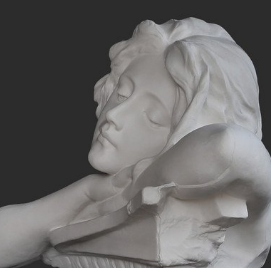The space of sculpture should be widely understood by the public. Sculpture is an art category that uses certain material materials and means to occupy a certain space position in the real three-dimensional space to shape a visible static art image. From a purely physical point of view, there is no difference between sculpture and installation in terms of space. But a work of art can never be an objective existence of a simple entity. As a sculpture, the volume of three-dimensional space is the most fundamental thing in its artistic language, so the concave, convex, spacing, fracture, penetration and size of the work itself is one of the purposes of sculpture. Although sculpture can also realize the transformation from three-dimensional to two-dimensional space, three-dimensional space is the root of its life, for example, Henry Moore's exploration of pure space. For installation art, three-dimensional volume is a necessary medium for its presentation. It is just a carrier to bear certain thoughts and ideas. Therefore, it is meaningless to discuss the volume, sense of quantity, rhythm and other factors that are very fundamental in the sculpture language in the installation art. Just as in Chinese painting, lines themselves have a purpose, while in western traditional art, lines exist more as a means. Hainan Sculpture
Sculpture, as a three-dimensional art existing in three-dimensional space, is considered impossible to be longer than the performance time. But in fact, sculpture art does not completely reject the concept of time. However, because most of the sculptures themselves are static forms, the time or movement they express comes from the common social experience and psychological feelings of artists and audiences. For example, the ancient Chinese portrait stone "Jingke Assassinating the King of Qin" shows two plots of the story at different times in the same picture. Another example is the soaring hands and flying discus in Miron's The Discus Thrower, the flying wings in Cavano's Cupid's Kiss, the huge dynamic and time process in Blair's Heracles the Archer and the ancient Indian statue Shiva Dancing Bronze Statue. Just like Lessing's statement on "the moment before the climax" in Laocoon:
All objects exist not only in space, but also in time. Objects last. They can show different appearances and be in different combinations in every moment of the duration. Such an instant appearance and combination is the consequence of the previous instant appearance and combination, and can also become the cause of the later instant appearance and combination, so it seems to be the center of a dynamic factor. Hainan Sculpture
If all these examples can only see the timeliness of the psychological reception of sculpture works, then the movable sculpture driven by machinery or natural power since the 20th century and the effect sculpture that uses sound, light, electricity and other principles to produce motion effects really let the sculpture move in a physical sense. For example, Calder's "Three Red Lines", George Rees's "Column" and many post-war Japanese artists' movable sculptures. However, although they dispel the concept of non temporality of sculpture to some extent, they are still clearly defined in the art category of sculpture, which is because the temporality they present exists in a non-linear mode, with uncertain characteristics, rather than narrative concept expression. So no matter what kind of movement forms, what they ultimately point to is the sculpture entity itself. Because sculpture, a mature discipline, has its own significance and prescriptiveness, the temporality in sculpture completely serves the aesthetic function or social function of the sculpture entity. The timeliness of installation art is obvious, even inherent. The timeliness of installation art is physically and psychologically integrated. For example, Jenny Anthony's "Eating Lard", the lard piece slowly melts and collapses in the passage of time. This movement is completely different from the movement of movable sculpture. The movement in installation art generally has a certain order, purpose, and internal development logic, and this logic is generally narrative, It can even be plot oriented or plot oriented. At the same time, it requires that the timeliness of the work movement must coincide with the psychological process of audience acceptance, because in essence, its movement is not subject to the entity in the work, but to better enable the audience to interpret the analytical concepts implied in the work, or the process itself is its purpose. Therefore, there are essential differences between the two in timeliness. Hainan Sculpture


